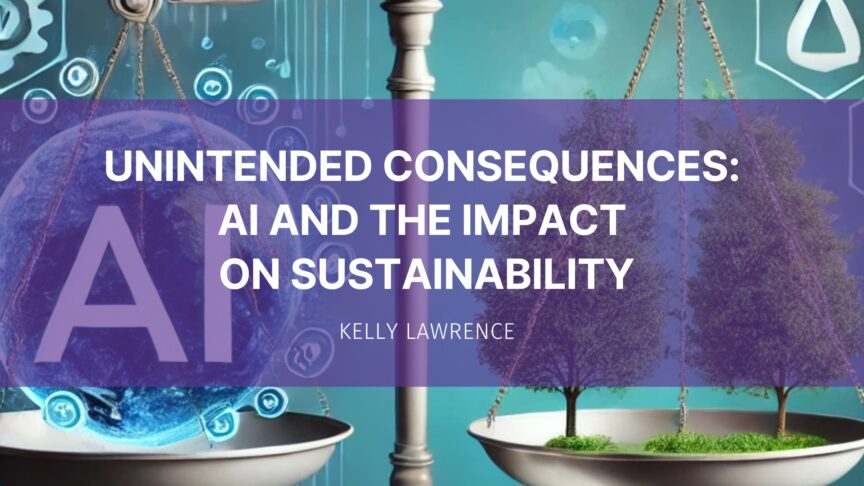The Double-Edged Sword of AI
In today’s fast-paced business environment, the integration of artificial intelligence (AI) has emerged as a powerful tool for driving growth and innovation. AI’s ability to analyze vast amounts of data, provide deep customer insights, and predict future trends offers businesses an unprecedented edge in understanding and meeting customer needs. In the business-to-business (B2B) space, AI has the potential to accelerate product development, enhance decision-making, and personalize customer experiences at scale. However, as with any transformative technology, the adoption of AI is not without its challenges, particularly when it comes to sustainability.
The environmental footprint of AI, especially when deployed at scale, is significant. From energy consumption to water usage and the resulting impact on local communities, the consequences of AI extend far beyond the immediate business benefits. As businesses increasingly rely on AI to maintain a competitive edge, it is crucial to consider the unintended consequences of its widespread use on the environment and society. This article explores both the advantages of AI and the key sustainability challenges it presents, arguing that corporations must take responsibility for evaluating the environmental impact of AI in their strategies and execution plans.

Balancing AI and Sustainability: “The delicate balance between AI-driven innovation and environmental sustainability—corporations must weigh the benefits of AI against its ecological impact.”
The AI Advantage: Unlocking Customer Insights
AI has revolutionized how businesses understand and interact with their customers. In the B2B sector, where the stakes are high and the competition fierce, AI offers several key advantages:
- Enhanced Data Analysis: AI can quickly and accurately process vast amounts of data from various sources, including customer interactions, sales reports, and market trends. This capability allows businesses to identify patterns and trends that would be impossible to detect manually, leading to a deeper understanding of customer needs and preferences. For example, companies like Applied Marketing Science have leveraged AI-driven text analytics to uncover nuanced customer insights, enabling more targeted product development.
- Predictive Analytics: AI’s predictive capabilities allow businesses to anticipate future customer behaviors and market trends. By analyzing historical data, AI can forecast demand, identify potential market shifts, and suggest proactive measures. This foresight is invaluable in planning product development strategies, ensuring that new products meet market needs and have a higher chance of success.
- Personalization at Scale: AI enables businesses to deliver personalized customer experiences at scale. By analyzing individual customer data, AI can provide customized recommendations and solutions, enhancing customer satisfaction and loyalty. This level of personalization is a competitive advantage in today’s crowded marketplace, as demonstrated by companies like Bloomfire, which uses AI to create comprehensive knowledge bases that improve customer service and drive revenue growth.
- Accelerating Product Development: AI significantly speeds up the product development cycle by automating routine tasks and providing rapid data analysis. This allows development teams to focus on strategic activities and make faster, data-driven decisions. For instance, The AIM Institute’s AI-powered tools have helped companies conduct virtual discovery interviews, uncovering unmet customer needs and accelerating time-to-market for new products.
While these advantages of AI are compelling, they come with significant environmental and societal trade-offs that cannot be ignored.
The Environmental Impact of AI: A Growing Concern
As AI becomes more integrated into business operations, the environmental impact of the technology is increasingly under scrutiny. The data centers that power AI applications are a major source of concern, with their high energy and water consumption contributing to significant environmental degradation.

Data Center Resource Consumption: “Modern data centers, while crucial for AI and digital infrastructure, consume significant energy and water resources, impacting both the environment and local communities.”
- Energy Consumption: Data centers, essential for storing and processing the vast amounts of data used by AI systems, require enormous amounts of energy to operate. In the United States alone, data centers account for approximately 1.8% of electricity use, contributing around 0.5% of total U.S. greenhouse gas emissions according to an IOPScience article authored by Md Abu Bakar Siddik, Arman Shehabi and Landon Marston. The rapid growth of AI and other data-intensive technologies is expected to increase this demand, putting further strain on energy resources and exacerbating climate change. One industry report expects data centers will use 8% of total U.S. power by 2030.
- Water Usage: In addition to energy, data centers consume large quantities of water, both directly for cooling and indirectly through electricity generation. Studies show that one-fifth of U.S. data center servers rely on water from moderately to highly water-stressed regions. This dependence on scarce water resources not only intensifies local water scarcity but also poses significant risks to the long-term sustainability of these facilities. In water-scarce regions, the competition for water resources can have dire consequences for local communities and ecosystems.
- Community Disruption: The environmental impact of data centers extends beyond resource consumption to the disruption of local communities. In Granbury, Texas, for instance, a Bitcoin mining facility caused severe health problems among residents due to the noise pollution generated by the facility’s cooling systems. In this case, “mining” refers to the process of “proof-of-work mining. The computers withing the data center power the process and “miners” located around the world work to prevent data tampering through a complex cryptographic process. According to Time Magazine, the constant hum and roar from these systems led to migraines, heart palpitations, and other health issues, highlighting the often-overlooked social costs of data center operations.
- Noise Pollution and Health Risks: Noise pollution from data centers and mining facilities can have serious health consequences. The example of Granbury illustrates how the unchecked operation of these facilities can lead to chronic health problems for local residents. The facility’s noise levels often exceeded legal limits, causing sleep deprivation, stress, and anxiety among those living nearby. This situation underscores the need for stricter regulations and more responsible management of the environmental and social impacts of data centers.
- Sustainability Challenges in AI Adoption: The environmental footprint of AI is not just a technical issue but a strategic one. As businesses continue to integrate AI into their operations, they must consider the long-term sustainability of these practices. The energy-intensive nature of AI-driven data centers, combined with their significant water usage and community impact, raises important questions about the trade-offs involved in adopting AI at scale. Companies must weigh the benefits of AI against the potential harm to the environment and local communities.

Impact on Communities: A peaceful small town juxtaposed with a large, industrial data center in the background, highlighting the impact of noise pollution and technology on community life.
The Path Forward: Responsible AI Adoption
As AI continues to advance and become more pervasive, businesses have a responsibility to ensure that its adoption is both economically beneficial and environmentally sustainable. The following strategies can help companies achieve this balance:
- Strategic Placement of Data Centers: To minimize the environmental impact of AI, companies should strategically locate data centers in areas with lower water stress and a lower carbon footprint. This approach can significantly reduce the environmental footprint of AI operations. For example, placing data centers in regions with abundant renewable energy resources, such as solar and wind power, can lower their carbon and water intensity.
- Investment in Renewable Energy: Businesses should invest in renewable energy sources to power their AI-driven data centers. Directly connecting data centers to solar and wind farms ensures that their energy consumption has a minimal environmental impact. Additionally, companies can explore innovative cooling technologies, such as liquid immersion cooling, which can reduce the water and energy required for data center operations.
- Regulatory Compliance and Community Engagement: Companies must comply with local environmental regulations and engage with communities to address concerns related to noise pollution, water usage, and other impacts. Transparent communication and proactive measures can help mitigate the social costs of AI adoption and build trust with local stakeholders.
- Evaluation of Environmental Trade-Offs: Before incorporating AI into their strategies, businesses should conduct a thorough evaluation of the environmental trade-offs involved. This includes assessing the long-term sustainability of AI operations and considering alternative approaches that may have a lower environmental impact. Companies should prioritize investments in AI technologies that are both effective and environmentally responsible.
- Corporate Responsibility and Sustainability Goals: Finally, businesses must integrate sustainability goals into their AI strategies. This means going beyond compliance to actively reduce the environmental footprint of AI operations. By establishing sustainability targets and holding themselves accountable, companies can lead the way in responsible AI adoption.
Conclusion: The Need for Responsible AI Integration
The rise of AI presents both significant opportunities and substantial challenges for businesses and society. While AI’s ability to provide deep customer insights and accelerate product development is undeniable, the environmental and social costs of its widespread adoption are equally important. As corporations increasingly rely on AI to drive growth and innovation, they must also take responsibility for the unintended consequences of this technology.
By strategically managing the environmental impact of AI, businesses can ensure that their adoption of this powerful tool is sustainable and beneficial for all stakeholders. This requires a careful evaluation of the trade-offs involved, as well as a commitment to minimizing the environmental footprint of AI operations. Ultimately, responsible AI integration is not just about leveraging technology for competitive advantage—it’s about ensuring that this advantage is achieved without compromising the health of our planet and the well-being of our communities.

Responsible corporations balance environmental stewardship with technological advancement.

